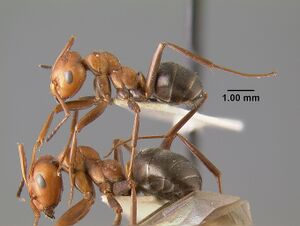Formica laeviceps
| Formica laeviceps | |
|---|---|

| |
| Scientific classification | |
| Kingdom: | Animalia |
| Phylum: | Arthropoda |
| Class: | Insecta |
| Order: | Hymenoptera |
| Family: | Formicidae |
| Subfamily: | Formicinae |
| Tribe: | Formicini |
| Genus: | Formica |
| Species group: | rufa |
| Species: | F. laeviceps |
| Binomial name | |
| Formica laeviceps Creighton, 1940 | |
This ant nests under stones, and occurs in areas with sandy soils and interspersed stones. Foragers were collected on Yucca sp. stalks, tending aphids, on a sunny, east-facing slope.
Identification
Workers lacking erect hairs on the scape (except at apex) and with few erect hairs on the mid and hind tibiae, except for a double row of bristles, each with up to 10 hairs, which extend the entire length of the tibia. The tentorial pits are very deep and pit-like, making the middle part of the clypeus rise up as a rectangle. The species name suggests that the head is smooth, but it is predominantly rough and only slightly smoother than the average member of the rufa group. (Mackay and Mackay 2002)
Keys including this Species
Distribution
Western Unites States.
Latitudinal Distribution Pattern
Latitudinal Range: 46.2° to 34.156971°.
| North Temperate |
North Subtropical |
Tropical | South Subtropical |
South Temperate |
- Source: AntMaps
Distribution based on Regional Taxon Lists
Nearctic Region: United States (type locality).
Distribution based on AntMaps
Distribution based on AntWeb specimens
Check data from AntWeb
Countries Occupied
| Number of countries occupied by this species based on AntWiki Regional Taxon Lists. In general, fewer countries occupied indicates a narrower range, while more countries indicates a more widespread species. |

|
Estimated Abundance
| Relative abundance based on number of AntMaps records per species (this species within the purple bar). Fewer records (to the left) indicates a less abundant/encountered species while more records (to the right) indicates more abundant/encountered species. |

|
Habitat
Mackay and Mackay (2002) - Semiarid sites, grasslands, pinyon-juniper forests, up into mixed conifer habitats (Fagerlund, pers. comm.).
Biology
Nevada, Wheeler and Wheeler (1986) - We have 8 records from 7 localities; 4,200-7,100 ft. One was in the Coniferous Forest Biome and 1 in the Cool Desert. Only 1 nest was described: in an asymmetrical thatch mound 86 x 107 cm in diameter and 56 cm in height. Workers from a Battle Mt. nest were tending Zyxaphis lililolia Gill. & Palmer (Homoptera: Aphididae; det. D. Hille Ris Lambers) on Artemisia tridentata.
Nest site selected in areas of moderate to sparse cover. Nest begun under log or stone with many of the passages running into the soil. Moderate use made of thatching, often little of this visible on the outside of the nest. Large domes or heaps of thatching rarely produced (Creighton, 1940).
Castes
Worker
   
| |
| . | Owned by Museum of Comparative Zoology. |
Images from AntWeb
   
| |
| Paratype of Formica laeviceps. Worker. Specimen code casent0105750. Photographer April Nobile, uploaded by California Academy of Sciences. | Owned by USNM, Washington, DC, USA. |
Queen
Images from AntWeb
    
| |
| Paratype of Formica laeviceps. Queen (alate/dealate). Specimen code casent0103373. Photographer April Nobile, uploaded by California Academy of Sciences. | Owned by USNM, Washington, DC, USA. |
Nomenclature
The following information is derived from Barry Bolton's Online Catalogue of the Ants of the World.
- laeviceps. Formica rufa subsp. laeviceps Creighton, 1940a: 9, fig. 1 (w.q.) U.S.A. Raised to species: Creighton, 1950a: 491.
Description
References
- Creighton, W. S. 1940a. A revision of the North American variants of the ant Formica rufa. American Museum Novitates 1055: 1-10.(page 9, worker, queen described)
- Creighton, W. S. 1950a. The ants of North America. Bulletin of the Museum of Comparative Zoology 104: 1-585 (page 491, raised to species)
- Mackay, W. P. and E. Mackay. 2002. The ants of New Mexico (Hymenoptera: Formicidae). Edwin Mellen Press, Lewiston, NY.
- Wheeler, G. C. and J. Wheeler. 1986. The ants of Nevada. Natural History Museum of Los Angeles County, Los Angeles.
References based on Global Ant Biodiversity Informatics
- Allred D. M. 1982. Ants of Utah. The Great Basin Naturalist 42: 415-511.
- Allred, D.M. 1982. The ants of Utah. Great Basin Naturalist 42:415-511.
- Gregg, R.T. 1963. The Ants of Colorado.
- Mackay W. P., and E. E. Mackay. 2002. The ants of New Mexico (Hymenoptera: Formicidae). Lewiston, New York: Edwin Mellen Press, 400 pp.
- Wheeler G. C., and J. Wheeler. 1986. The ants of Nevada. Los Angeles: Natural History Museum of Los Angeles County, vii + 138 pp.
- Wheeler G. C., and J. Wheeler. 1987. A Checklist of the Ants of South Dakota. Prairie Nat. 19(3): 199-208.
- Wheeler, G.C. and J. Wheeler. 1988. A checklist of the ants of Montana. Psyche 95:101-114

